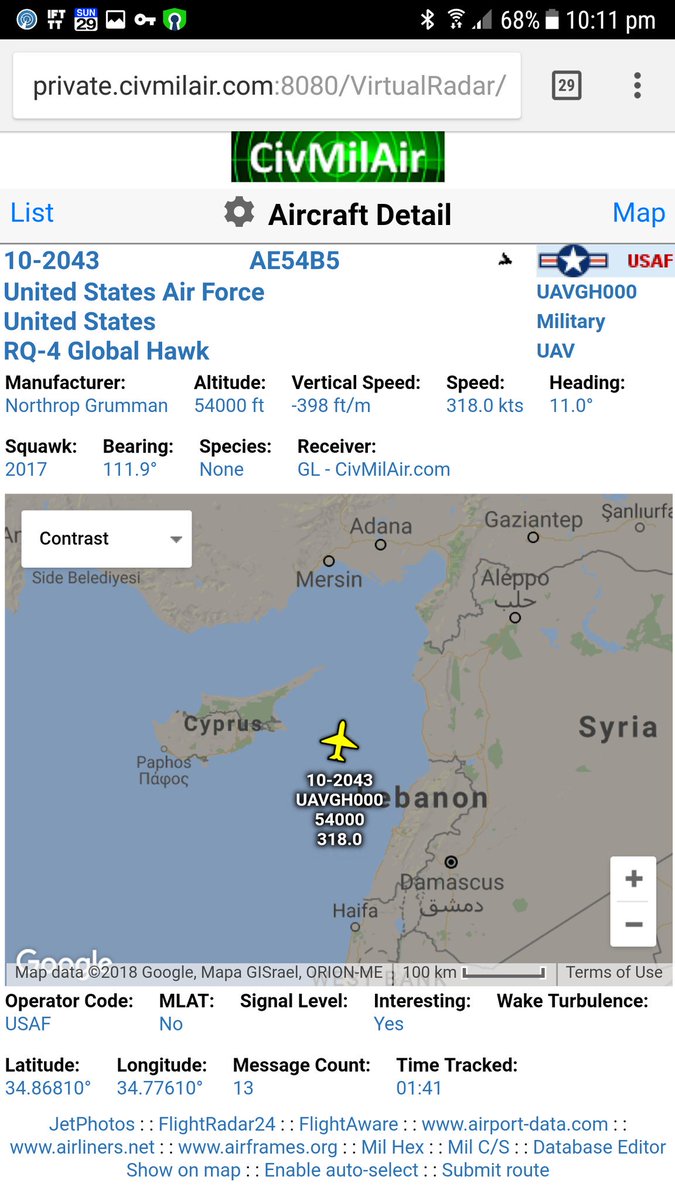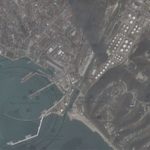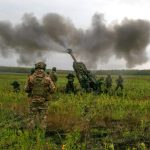Preliminary – Battle Damage Assessment (P-BDA) – On April 29, 2018, 2230 local time, a round of unclaimed military strikes pounded locations jointly operated by the Bashar al-Assad regime and Iran in Syria. The targeted sites are: the 47th Brigade Military Base in Hama province (Objective-Alpha/ O-A) and the Zeido Auto Test Center near Aleppo Airport (Objective-Bravo/ O-B). The Syrian government and its allies are accusing the United States and Israel for being behind the strike. The following P-BDA assessed by T-intelligence (Ti) outlines the nature of the targets acquired for striking, and determines why the Israeli Air Force (IAF) was most likely behind the attack – with limited U.S. support or knowledge.
Huge explosions in #Salhab in #Hama province as Iranian and Syrian military sites were targeted by Israeli warplanes pic.twitter.com/pMZUAn5Ns4
— Abdo AJ (@Syrianzo) April 29, 2018
Target-Acquisition Process
(1) The first target (Objective Alpha/ O-A) is located near the village of al-Safira (10 km south of Hama city) and is a key military barracks and logistics hub for operations ongoing in the Hama war room. The facility hosts a personnel housing center, various command & control compounds and many weapons storage bunkers. It also sits next to a major (officially) porcelain factory, rumored to be used for weapons manufacturing. The base is jointly operated by the Syrians and Iranian elements: both Revolutionary Guards Corps (IRGC) and affiliated indigenous paramilitary units.

Satellite imagery analysis highlights various compounds and buildings that compose the 47th Brigade Military Base, but also the exact sites that were pounded. (T-intelligence)
(2) The second target (Objective Bravo/ O-B) is a warehouse in the Malikiyah industrial area next to the Aleppo Airport (Aleppo province). There is little information available about this location, except that it was not a military facility, but civilian. Given its proximity to the Aleppo International Airport, Ti assesses that the buildings might have been used as a clandestine weapons storage center for fresh deliveries landing in Aleppo from Iran, before being distributed to other regional war-room hubs. This is would be a rational increase in tradecraft and counter-surveillance methods to avoid Israeli Intelligence efforts of monitoring hangars and warehouses in the Airport itself for target-acquisition – since the IAF managed to succefully identify and strike all of Iran’s favorite hangars in the Al-Assad International Airport in Damascus (for example).

Satellite imagery shows the location raided near Aleppo Airport. (T-intelligence)
3) O-A saw a round of successive explosions that amplified under a chain of secondaries (detonation of weapons, ammunition and ordinance deposited there). The European-Mediterranean Seismological Center recorded a disturbance registering 2.6 Richter magnitude scale caused by the blast in the area. The British-based Syrian Observatory for Human Rights (SOHR) notes that at least 26 people have been killed, and around 60 have been injured – most of them Iranian, and a few (confirmed) Syrian soldiers.
4) O-B was hit around the same time but the target and ordinance employed was far limited and reduced. No casualties reported from this site. Reports indicate that it was emptied.
Maintaining Military Initiative: Preempting Retaliation
Since the Syrian Civil War boosted Iranian activity inside Syria, Lebanon and around Israel’s borders, Jerusalem sought to balance its security needs and military interventions. Besides clandestine and limited supported for a few selected Opposition groups operating near the Golan Heights, Israeli opted for intelligence-based targeted air strikes on key Iranian facilities that proliferate advanced weapons transfers to Hezbollah – most concerning, long-range missiles. The Israeli Air Force (IAF) has conducted dozens of clandestine air raids against such objectives throughout Syria – the usual targets being in the wider Damascus area, Hama and Homs. The IAF’s policy is to not comment on external engagements in synchrony with Jerusalem’s policy of deniability. Based on the following findings Ti believes that this was another such shadow raid. However, this raised the stakes the highest at a time when Israeli-Iranian tensions are critical.
(5) Hours before the 22:30 strikes, a phone call was made between U.S. President Donald J. Trump and Israeli Prime-Minister B. Netanyahu. They spoke about the deteriorating situation in the region and about Iranian activity in Syria. The conversation most certainly revolved around the upcoming strikes, with President Trump being either informed or coordinated with. We cannot rule out the possibility that the U.S. has supported the shadow-raid at least politically.
(6) The Israeli Government was anxiously anticipating a military retaliation after its shadow air operation against Iran at the strategic T-4 airbase near Palmyra/ Tadmur, Homs province, Syria. The attack was conducted in March 2018 and destroyed several hangars, warehouses, while killing four Iranian soldiers. This base was a strategic hub linking Iranian-affiliated personnel and assets flowing from Iraq and Syria for combat operations. The Iranian Government delegated its in-field “mastermind” Qasim Soleimani of the IRGC to draft and plan a military response against Israel. This also led to the IAF canceling its participation in a joint exercise with the U.S. in Alaska – all assets were needed home. Ti judges that Israel was monitoring consistent military logistics arriving into Syria to conduct or support that strike.

Satellite imagery shows aftermath of the April 29th clandestine raid (iSi) over the 47th Brigade Military Base – locations can be seen in the wider visual context on previous map sourced by Ti.
(7) The data of a civilian airline monitoring app shows that on April 29, a Syrian Arab Air Force 585th Transport Squadron (of the 29th Air Brigade’s four-engine turbofan strategic airlifter Ilyushin Il-76T YK-ATD) flew from Tehran Mehrabad (Iran) to -most likely – Hama Airport (Syria). After a short stop there, probably to unload and distribute some of the cargo to O-A (located just 10 km from Hama City), the plane flew to Damascus International Airport. It is highly likely that the cargo contained important capabilities, such as medium-to-long range missiles, purposely deployed to take-part in the Iranian-planned retaliation against Israel for the T-4 raid. [Added: Intelligence from on May 2nd, 2018 suggests that the cargo contained anti-aircraft surface-to-air missiles (SAM)]. Ti determined that even without this circumstantial evidence, O-A was an important enough target to tempt Jerusalem to strike. Yet, no photographs of ordinance remnants have surfaced online yet to assess whether it was an airstrike or a surface-to-surface attack from a missile battery. OSINT reports claim that around 200 Iranian missiles were destroyed by the raid.

Path of flight number RB9236 from Tehran to unknown (most certainly Hama) and then to Damascus. (Social Media source)
(8) O-B’s importance comes from the cargo it was believed to be sheltering – however, there is no indication that weapons or missiles were there during the strike. But in this case, photos from the blast site were issued on Social Media. They show remnants of the missile dropped on the target. Crowdsourcing efforts identified the ordinance as being the GBU-39 Small Diameter Bomb. This is a GPS-aided and high-accuracy ordinance produced by Boeing to strike fixed targets (depots, bunkers, storage buildings). It is currently in use by the U.S., Israel, Italy and Saudi Arabia, and it can be launched by a number of widely used fighter jets and bombers, such as the F-15E (in use by both IAF and USAF), Tornado, Gripen, F-16 (in use by both IAF and USAF), and AC-130.

Analysis of a Social Media source compares ordinance wreckage with the GBU-39.
(9) Syrian-affiliated media claims that the U.S hit its base in Hama using assets in northern Jordan. While it is highly unlikely that the Kingdom of Jordan would have approved such an act to be committed from its soil, the U.S. does have an active military deployment in the country. It also controls a large swat of land around the al-Tanf area (Syria) through friendly Opposition groups operating there. The military deployment also contains an ingredient that might fit the description – the M142 High Mobility Artillery Rocket System (HIMARS). That is a light-truck mounted long-range rocket system. Not only it is deployed in Jordan, but since early-2017, sources in the Pentagon confirmed for CNN that it was moved over the border in south-eastern Syria. The purpose was to support the Opposition groups operating around the al-Tanf garrison in deterring regime attacks and in launching strikes against ISIS. The HIMARS can strike targets up to 400 km distance, which also includes O-A in Hama, but not O-B in Aleppo.
(10) It is highly likely that the explosions at O-A and O-B were caused by a round of Israeli Air Force (IAF) “shadow” preemptive strikes purposed to degrade capabilities deployed by Iran to support a military retaliation against Israel. The United States was certainly informed beforehand, but it is unlikely that it played any role in the military operation despite key assets being in place. Back in April 21st, John Bolton pitched President Trump to include a list of Iranian-operated targets in the line-up of possible strike locations for his retaliation on the Assad’s regime use of Chemical Weapons in Douma. President Trump refused and bowed to Secretary of Defense James Mattis’ more-proportionate options. Both of the targets were a concern for Israeli national security, which would not mandate the President to change his mind over such a sensitive issue so fast and in such an offensive manner. This does not mean that the administration did not seek to embolden and encourage Jerusalem to conduct the strikes it saw adequate.

One sample from the Social Media source that shows the RQ-4 Global Hawk west of the Syrian coastline around 00:12 local time.
(11) The U.S. was certainly informed about the operation and had unmanned aerial surveillance assets (UAV) active to provide Intelligence, Surveillance and Recoinassance (ISR) of the IAF strikes. A reputable Social Media source with access to civil and military air traffic data had noticed a U.S. Air Force (USAF)-operated RQ-4 Global Hawk drone conducting IMINT sorties over western Syria. Call sign UAVGH 0000, probably outbound from Sigonela or Aviano, regularly conducts such runs in the Eastern Mediterranean. However, on April 29, 1900 hours (local time) it was spotted turning back towards the Syrian coastline after completing the Levant-Sinai flight route. At 1943 hours the drone was already near Haifa (northern Israel). In that evening, UAVGH0000 assumed 54,000 feet altitude. The drone re-appeared several hours later that night after the IAF strikes. On April 30, 0012 hours the drone continued circling the same position. For almost three hours, the drone was most probably conducting a post-operation BDA before heading back to base. Whatever happened that night in Hama and Aleppo, the USAF Global Hawk drone was watching.
(12) Syrian anti-air defense systems – as the S-200 – were successfully by-passed again. There are no reports of retaliatory fire neither on the delivery systems (batteries or fighter jets) nor on the missiles themselves. Russian assets were still not activate.
(13) Israeli-Iranian tensions continue to boil as no external power manages to contain the situation from escalating into an open war. Following an almost two-hour ministerial meeting in Jerusalem, Prime Minister Netanyahu informed the U.S. and Russia that if Tehran strikes back, then Israel will “got to town” on all Iranian bases in Syria. The Government in Tehran issued more threats indicating an imminent retaliation of some sort.
(14) The shadow-raid came in a sensitive context, as the Trump administration is expected to decided on whether to keep the U.S. in the Joint Comprehensive Action Plan (JCAP) or the “Iranian nuclear deal” by May 12, 2018. The Israelis and President Trump have stepped up criticism of the deal and of Iran’s activities in Syria.
by HARM
Founder of T-Intelligence. OSINT analyst & instructor, with experience in defense intelligence (private sector), armed conflicts, and geopolitical flashpoints.





